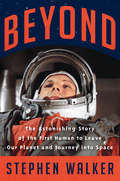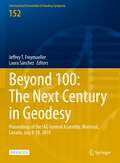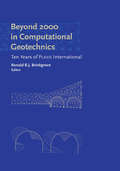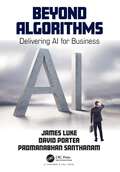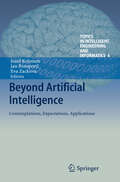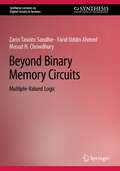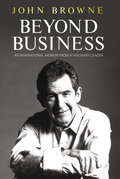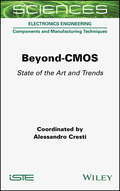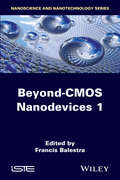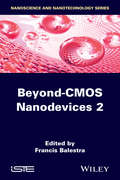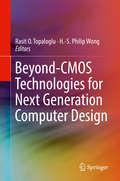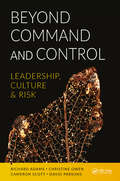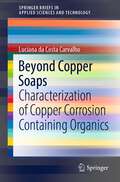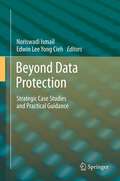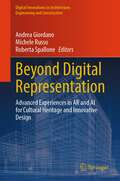- Table View
- List View
Beyond
by Stephen WalkerA thrilling tale of one of humanity’s greatest adventures, a battle of wits, will, genius and extraordinary courage as the Soviets and Americans raced to put the first human in space.
Beyond 100: Proceedings of the IAG General Assembly, Montreal, Canada, July 8-18, 2019 (International Association of Geodesy Symposia #152)
by Jeffrey T. Freymueller Laura SánchezThis open access book contains 30 peer-reviewed papers based on presentations at the 27th General Assembly of the International Union of Geodesy and Geophysics (IUGG). The meeting was held from July 8 to 18, 2019 in Montreal, Canada, with the theme being the celebration of the centennial of the establishment of the IUGG. The centennial was also a good opportunity to look forward to the next century, as reflected in the title of this volume. The papers in this volume represent a cross-section of present activity in geodesy, and highlight the future directions in the field as we begin the second century of the IUGG. During the meeting, the International Association of Geodesy (IAG) organized one Union Symposium, 6 IAG Symposia, 7 Joint Symposia with other associations, and 20 business meetings. In addition, IAG co-sponsored 8 Union Symposia and 15 Joint Symposia. In total, 3952 participants registered, 437 of them with IAG priority. In total, there were 234 symposia and 18 Workshops with 4580 presentations, of which 469 were in IAG-associated symposia.
Beyond 2000 in Computational Geotechnics
by Ronald B. J. BrinkgreveThis volume contains papers presented during the first international PLAXIS symposium. Topics covered include: general geo-technical aspects; tunnels and deep excavations, and education and research. This pack is meant for the user of the PLAXIS program, as well as engineers and researchers.
Beyond 2000 in Computational Geotechnics
by Ronald B.J. BrinkgreveThis volume contains papers presented during the first international PLAXIS symposium. Topics covered include: general geo-technical aspects; tunnels and deep excavations, and education and research. This pack is meant for the user of the PLAXIS program, as well as engineers and researchers.
Beyond 3G - Bringing Networks, Terminals and the Web Together: LTE, WiMAX, IMS, 4G Devices and the Mobile Web 2.0
by Martin SauterGiving a sound technical introduction to 3GPP LTE and SAE, this book explains the decisions taken during standardization while also examining the likely competition for LTE such as HSPA+ and WiMAX. As well as looking at next generation network technologies, Beyond 3G - Bringing Networks, Terminals and the Web Together describes the latest mobile device developments, voice and multimedia services and the mobile web 2.0. It considers not only how the systems, devices and software work but also the reasons behind why they are designed in this particular way. How these elements strongly influence each other is discussed as well as how network capabilities, available bandwidth, mobile device capabilities and new application concepts will shape the way we communicate in the future. This book gives an end to end introduction to wireless, from mobile software architecture to core networks, making it a valuable resource for anyone working in the industry. Examines current and next-generation network technologies such as UMTS, HSPA+, WiMAX, LTE and Wifi Analyses and explains performance and capacity in practice as well as future capacity requirements and how they can be fulfilled Introduces the reader to the current cellular telephony architecture and to voice over IP architectures such as SIP, IMS and TISPAN Looks at mobile device hardware and mobile operating system evolution Encompasses all major global wireless standards for application development and the latest state of the mobile web 2.0
Beyond 3G - Bringing Networks, Terminals and the Web Together: LTE, WiMAX, IMS, 4G Devices and the Mobile Web 2.0
by Martin SauterGiving a sound technical introduction to 3GPP LTE and SAE, this book explains the decisions taken during standardization while also examining the likely competition for LTE such as HSPA+ and WiMAX. As well as looking at next generation network technologies, Beyond 3G - Bringing Networks, Terminals and the Web Together describes the latest mobile device developments, voice and multimedia services and the mobile web 2.0. It considers not only how the systems, devices and software work but also the reasons behind why they are designed in this particular way. How these elements strongly influence each other is discussed as well as how network capabilities, available bandwidth, mobile device capabilities and new application concepts will shape the way we communicate in the future. This book gives an end to end introduction to wireless, from mobile software architecture to core networks, making it a valuable resource for anyone working in the industry. Examines current and next-generation network technologies such as UMTS, HSPA+, WiMAX, LTE and Wifi Analyses and explains performance and capacity in practice as well as future capacity requirements and how they can be fulfilled Introduces the reader to the current cellular telephony architecture and to voice over IP architectures such as SIP, IMS and TISPAN Looks at mobile device hardware and mobile operating system evolution Encompasses all major global wireless standards for application development and the latest state of the mobile web 2.0
Beyond Airline Disruptions: Thinking and Managing Anew
by Jasenka RapajicFlight disruptions continue to thrive unnoticed, invisibly eroding airline profitability and causing growing passenger dissatisfaction. This is especially critical at airports where traffic expansion outstrips airport capacities. Hampered by legacy information systems, management practices and organisational detachments, decision makers across the industry have little or no understanding of the multiple causes of disruptions and their implications. Consequently, their actions are focused on resolving local problems without being synchronised at system level. As problematic as they are, disruptions create opportunities for learning about system interactions, a solid and appropriate foundation for resolving complex industry issues. Beyond Airline Disruptions explains how airlines can become more competitive by utilising unexplored potential for gradual, consistent and measurable improvements, centred around cost and quality of operational performance. It describes practical methods and techniques essential for turning these ideas into daily practices. This second, revised edition features updated content that introduces a fresh approach to airline management and decision making, more in line with future industry needs. It bridges the gaps between strategy and operations and inspires collaboration between airlines, airports, ATC, service providers and regulators to bring longer-lasting benefits not only for industry participants and passengers, but also for the economy, society and the environment.
Beyond Airline Disruptions: Thinking and Managing Anew
by Jasenka RapajicFlight disruptions continue to thrive unnoticed, invisibly eroding airline profitability and causing growing passenger dissatisfaction. This is especially critical at airports where traffic expansion outstrips airport capacities. Hampered by legacy information systems, management practices and organisational detachments, decision makers across the industry have little or no understanding of the multiple causes of disruptions and their implications. Consequently, their actions are focused on resolving local problems without being synchronised at system level. As problematic as they are, disruptions create opportunities for learning about system interactions, a solid and appropriate foundation for resolving complex industry issues. Beyond Airline Disruptions explains how airlines can become more competitive by utilising unexplored potential for gradual, consistent and measurable improvements, centred around cost and quality of operational performance. It describes practical methods and techniques essential for turning these ideas into daily practices. This second, revised edition features updated content that introduces a fresh approach to airline management and decision making, more in line with future industry needs. It bridges the gaps between strategy and operations and inspires collaboration between airlines, airports, ATC, service providers and regulators to bring longer-lasting benefits not only for industry participants and passengers, but also for the economy, society and the environment.
Beyond Algorithms: Delivering AI for Business
by James Luke David Porter Padmanabhan SanthanamWith so much artificial intelligence (AI) in the headlines, it is no surprise that businesses are scrambling to exploit this exciting and transformative technology. Clearly, those who are the first to deliver business-relevant AI will gain significant advantage. However, there is a problem! Our perception of AI success in society is primarily based on our experiences with consumer applications from the big web companies. The adoption of AI in the enterprise has been slow due to various challenges. Business applications address far more complex problems and the data needed to address them is less plentiful. There is also the critical need for alignment of AI with relevant business processes. In addition, the use of AI requires new engineering practices for application maintenance and trust. So, how do you deliver working AI applications in the enterprise? Beyond Algorithms: Delivering AI for Business answers this question. Written by three engineers with decades of experience in AI (and all the scars that come with that), this book explains what it takes to define, manage, engineer, and deliver end-to-end AI applications that work. This book presents Core conceptual differences between AI and traditional business applications A new methodology that helps to prioritise AI projects and manage risks Practical case studies and examples with a focus on business impact and solution delivery Technical Deep Dives and Thought Experiments designed to challenge your brain and destroy your weekends
Beyond Algorithms: Delivering AI for Business
by James Luke David Porter Padmanabhan SanthanamWith so much artificial intelligence (AI) in the headlines, it is no surprise that businesses are scrambling to exploit this exciting and transformative technology. Clearly, those who are the first to deliver business-relevant AI will gain significant advantage. However, there is a problem! Our perception of AI success in society is primarily based on our experiences with consumer applications from the big web companies. The adoption of AI in the enterprise has been slow due to various challenges. Business applications address far more complex problems and the data needed to address them is less plentiful. There is also the critical need for alignment of AI with relevant business processes. In addition, the use of AI requires new engineering practices for application maintenance and trust. So, how do you deliver working AI applications in the enterprise? Beyond Algorithms: Delivering AI for Business answers this question. Written by three engineers with decades of experience in AI (and all the scars that come with that), this book explains what it takes to define, manage, engineer, and deliver end-to-end AI applications that work. This book presents Core conceptual differences between AI and traditional business applications A new methodology that helps to prioritise AI projects and manage risks Practical case studies and examples with a focus on business impact and solution delivery Technical Deep Dives and Thought Experiments designed to challenge your brain and destroy your weekends
Beyond Artificial Intelligence: Contemplations, Expectations, Applications (Topics in Intelligent Engineering and Informatics #4)
by Jozef Kelemen Jan Romportl Eva ZackovaProducts of modern artificial intelligence (AI) have mostly been formed by the views, opinions and goals of the “insiders”, i.e. people usually with engineering background who are driven by the force that can be metaphorically described as the pursuit of the craft of Hephaestus. However, since the present-day technology allows for tighter and tighter mergence of the “natural” everyday human life with machines of immense complexity, the responsible reaction of the scientific community should be based on cautious reflection of what really lies beyond AI, i.e. on the frontiers where the tumultuous ever-growing and ever-changing cloud of AI touches the rest of the world. The chapters of this boo are based on the selected subset of the presentations that were delivered by their respective authors at the conference “Beyond AI: Interdisciplinary Aspects of Artificial Intelligence” held in Pilsen in December 2011. From its very definition, the reflection of the phenomena that lie beyond AI must be inherently interdisciplinary. And so is this book: all the authors took part in a mutual transdisciplinary dialogue after explaining their views on AI not only to a narrow selection of their usual close peers with the same specialisation, but to a much broader audience of various experts from AI engineering, natural sciences, humanities and philosophy. The chapters of this book thus reflect results of such a dialogue.
Beyond Binary Memory Circuits: Multiple-Valued Logic (Synthesis Lectures on Digital Circuits & Systems)
by Zarin Tasnim Sandhie Farid Uddin Ahmed Masud H. ChowdhuryThis book provides readers with an overview of the fundamental definitions and features of Multiple-Valued Logic (MVL). The authors include a brief discussion of the historical development of MVL technologies, while the main goal of the book is to present a comprehensive review of different technologies that are being explored to implement multiple-valued or beyond-binary memory circuits and systems. The discussion includes the basic features, prospects, and challenges of each technology, while highlighting the significant works done on different branches of MVL memory architecture, such as sequential circuits, random access memory, Flash memory, etc.
Beyond Business: An Inspirational Memoir From a Visionary Leader
by John Browne'John Browne, chief executive of BP from 1995-2007, tells how he built the oil group from a "two pipeline company" to a global giant. A good insider's account of a fascinating industry' Financial TimesOnce a lacklustre organisation, BP became one of the world's biggest, most successful and most admired companies in the new millennium. John Browne, the company's CEO for 12 years, invented the oil 'supermajor' and led the way on issues such as climate change, human rights and transparency.In BEYOND BUSINESS, Browne brings to life what he learned about leadership in a tough industry. His story encompasses the insights gained as he transformed a national company, challenged an entire industry and prompted political and business leaders to change. He takes us across the world on adventures that include going toe-to-toe with both tyrants and elected leaders, and involve engineering feats which in many ways rival those of going to the moon. And he shares his views on the true purpose of business and the leadership needed to tackle the grand challenges of our era.It is also a story of failure and human frailty, as Browne reveals how his private and public lives collided at frightening speed in full view of the world, prompting his abrupt resignation as CEO of BP.
Beyond-CMOS: State of the Art and Trends
by Alessandro CrestiRecent advances in physics, material sciences and technology have allowed the rise of new paradigms with bright prospects for digital electronics, going beyond the reach of Moore's law, which details the scaling limit of electronic devices in terms of size and power. This book presents original and innovative topics in the field of beyond CMOS electronics, ranging from steep slope devices and molecular electronics to spintronics, valleytronics, superconductivity and optical chips. Written by globally recognized leading research experts, each chapter of this book will provide an introductory overview of their topic and illustrate the state of the art and future challenges. Aimed not only at students and those new to this field, but also at well-experienced researchers, Beyond-CMOS provides extremely clear and exciting perspectives about the technology of tomorrow, and is thus an effective tool for understanding and developing new ideas, materials and architectures.
Beyond-CMOS: State of the Art and Trends
by Alessandro CrestiRecent advances in physics, material sciences and technology have allowed the rise of new paradigms with bright prospects for digital electronics, going beyond the reach of Moore's law, which details the scaling limit of electronic devices in terms of size and power. This book presents original and innovative topics in the field of beyond CMOS electronics, ranging from steep slope devices and molecular electronics to spintronics, valleytronics, superconductivity and optical chips. Written by globally recognized leading research experts, each chapter of this book will provide an introductory overview of their topic and illustrate the state of the art and future challenges. Aimed not only at students and those new to this field, but also at well-experienced researchers, Beyond-CMOS provides extremely clear and exciting perspectives about the technology of tomorrow, and is thus an effective tool for understanding and developing new ideas, materials and architectures.
Beyond-CMOS Nanodevices 1
by Francis BalestraThis book offers a comprehensive review of the state-of-the-art in innovative Beyond-CMOS nanodevices for developing novel functionalities, logic and memories dedicated to researchers, engineers and students. It particularly focuses on the interest of nanostructures and nanodevices (nanowires, small slope switches, 2D layers, nanostructured materials, etc.) for advanced More than Moore (RF-nanosensors-energy harvesters, on-chip electronic cooling, etc.) and Beyond-CMOS logic and memories applications.
Beyond-CMOS Nanodevices 1
by Francis BalestraThis book offers a comprehensive review of the state-of-the-art in innovative Beyond-CMOS nanodevices for developing novel functionalities, logic and memories dedicated to researchers, engineers and students. It particularly focuses on the interest of nanostructures and nanodevices (nanowires, small slope switches, 2D layers, nanostructured materials, etc.) for advanced More than Moore (RF-nanosensors-energy harvesters, on-chip electronic cooling, etc.) and Beyond-CMOS logic and memories applications.
Beyond-CMOS Nanodevices 2
by Francis BalestraThis book offers a comprehensive review of the state-of-the-art in innovative Beyond-CMOS nanodevices for developing novel functionalities, logic and memories dedicated to researchers, engineers and students. The book will particularly focus on the interest of nanostructures and nanodevices (nanowires, small slope switches, 2D layers, nanostructured materials, etc.) for advanced More than Moore (RF-nanosensors-energy harvesters, on-chip electronic cooling, etc.) and Beyond-CMOS logic and memories applications.
Beyond-CMOS Nanodevices 2
by Francis BalestraThis book offers a comprehensive review of the state-of-the-art in innovative Beyond-CMOS nanodevices for developing novel functionalities, logic and memories dedicated to researchers, engineers and students. The book will particularly focus on the interest of nanostructures and nanodevices (nanowires, small slope switches, 2D layers, nanostructured materials, etc.) for advanced More than Moore (RF-nanosensors-energy harvesters, on-chip electronic cooling, etc.) and Beyond-CMOS logic and memories applications.
Beyond-CMOS Technologies for Next Generation Computer Design
by Rasit O. Topaloglu H.-S. Philip WongThis book describes the bottleneck faced soon by designers of traditional CMOS devices, due to device scaling, power and energy consumption, and variability limitations. This book aims at bridging the gap between device technology and architecture/system design. Readers will learn about challenges and opportunities presented by “beyond-CMOS devices” and gain insight into how these might be leveraged to build energy-efficient electronic systems.
Beyond Command and Control: Leadership, Culture and Risk
by Richard Adams Christine Owen Cameron Scott David Phillip ParsonsThis book will advance the understanding of leadership beyond the inherited myths and modalities of command and control. Leadership is separated from ideas and institutional seniority and explained as the collaborative power of one with others. Enabling the intelligent co-participation of all people, the constructive effect of this approach to leadership is in the engagement of people. This is significant when task accomplishment depends not on managerial direction, but on the interaction of people with each other, with technical systems, and with complex regulations which are often across jurisdictional boundaries. Examples and case studies are included.
Beyond Command and Control: Leadership, Culture and Risk
by Richard Adams Christine Owen Cameron Scott David Phillip ParsonsThis book will advance the understanding of leadership beyond the inherited myths and modalities of command and control. Leadership is separated from ideas and institutional seniority and explained as the collaborative power of one with others. Enabling the intelligent co-participation of all people, the constructive effect of this approach to leadership is in the engagement of people. This is significant when task accomplishment depends not on managerial direction, but on the interaction of people with each other, with technical systems, and with complex regulations which are often across jurisdictional boundaries. Examples and case studies are included.
Beyond Copper Soaps: Characterization of Copper Corrosion Containing Organics (SpringerBriefs in Applied Sciences and Technology)
by Luciana da CarvalhoThis book reports a series of electrochemical experiments where copper was corroded in the presence of various organic substances. Combining data from spectroscopy techniques, X-ray diffraction and mass spectrometry (including proteomics) the experiments demonstrate that copper-organic complexes can be formed during the corrosion of copper. The low solubility of copper-organic complexes in organic solvents and their amorphous nature mean that these compounds cannot be easily detected by one single analytical technique. This book benefits researchers investigating the presence of organic residues in archaeological copper corrosion and copper-organic complexes in art, where sampling is often subject to curatorial constraints.
Beyond Data Protection: Strategic Case Studies and Practical Guidance
by Noriswadi Ismail and Edwin Lee Yong CiehThe book deals with data protection issues from practical viewpoints. 40% of the content focus on the Malaysian Personal Data Protection Act (PDPA) 2010 progress, whilst 60% of the content focus on leading comparative practical guidance from Europe. Part of the PDPA provisions is mirrored from European approaches and practices. The approach of this book is straightforward, handy and readable and is supplemented by practical applications, illustrations, tables and diagrams. Practical examples highlighted in this book range from cloud computing, radio frequency identification technology, social media networks and information security to basic related aspects of data protection issues covering strategic leadership, management, governance and audit in businesses, organisations and local authorities. Recommended best practices have been outlined for practical guidance accompanied with future challenges and opportunities for Malaysia and ASEAN. The book is equally suitable for academics, practitioners, governmental officials and regulators dealing with data protection within their sector-specific legislation.
Beyond Digital Representation: Advanced Experiences in AR and AI for Cultural Heritage and Innovative Design (Digital Innovations in Architecture, Engineering and Construction)
by Andrea Giordano Michele Russo Roberta SpalloneThis book collects contributions which showcase the impact of new augmented reality (AR) and artificial intelligence (AI) technologies considered jointly in the fields of cultural heritage and innovative design. AR is an alternative path of analysis and communication if applied to several fields of research, in particular if related to space and artifacts in it. This happens because the neural network development strengthens the relationship between augmented reality and artificial intelligence, creating processes close to human thought in shorter times. In the last years, the AR/AI expansion and the future scenarios have raised a deep trans-disciplinary speculation. The disciplines of representation (drawing, surveying, visual communication), as a convergence place of multidisciplinary theoretical and applicative studies related to architecture, city, environment, tangible and intangible cultural heritage, are called to contribute to the international debate. The book chapters deal with augmented reality and artificial intelligence, analyzing their connections as research tools for knowing the environment. In particular, the topics focus on the intersection between real and virtual world and on the heuristic role of drawing in the enhancement and management of cultural heritage, in planning and monitoring the architecture, the environment, or the infrastructures. Scientists involved in AR and AI research applied separately or together in the field of cultural heritage, architectural design, urban planning, and infrastructures analysis, as well as members of public and private organizations make up interdisciplinary groups that fuel the discussion focusing on the priorities and aims of the research related to the disciplines of representation.
